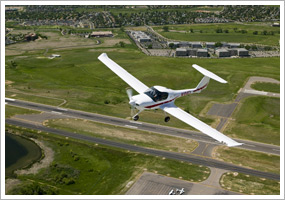Custom content for the Feb. 25, 2011, issue of 'AOPA ePilot' newsletter
| The following stories from the Feb. 25, 2011, edition of AOPA ePilot were provided to AOPA members who expressed an interest in the particular subject areas. Any AOPA member can receive information tailored to their areas of interest by updating their preferences online. |
training tipsWhat’s next? What else should a pilot be able to visualize a few minutes in advance? The traffic pattern entry—and there’s more to it than entering the proper pattern to the proper runway. Correcting for wind drift and changing groundspeed on the downwind, base, and final legs requires visualization. Suppose you determined from the ATIS broadcast that there will be a strong left crosswind on final. When flying the left downwind, will that wind cause you to drift toward the runway, or away from it, if left uncorrected? Turning left base, will your groundspeed decrease, or increase? Visualizing the conditions would help you avoid drifting too close on downwind or overshooting the final turn. If your flight instructor has asked you questions like these in the cockpit or on the ground, it’s because probing your ability to visualize is part of assessing your readiness to solo. Correct responses on your part demonstrate that you have learned how to transfer knowledge from your flight exercises, such as ground reference maneuvers, to the en route environment and the traffic pattern, as discussed in the answer to the Feb. 23, 2007, Final Exam question, which notes: “With practice it will become second nature to divide your attention between the mechanics of making the turn and the subtleties of adjusting the turn rate as needed to compensate for wind drift.” Speaking of the traffic pattern, being able to visualize where to spot reported traffic depends on your familiarity with pattern operations and knowing a bit about other aircraft types (see the Jan. 10, 2003, “Training Tip: Name that Plane” ), such as their approximate approach speeds. training productsAirmiler tape measure from Aircraft SprucePlanning a long, long cross-country? The Pilot’s Airmiler tape measure is a durable metal tape measure that measures mileage on aeronautical charts. The tape measure includes sectional scale (1:500,000) on one side and world aeronautical chart scale (1:1,000,000) on the other. Kilometers, statute, and nautical miles are shown on both sides. It sells for $19.95 from Aircraft Spruce and Specialty. Note: Products listed have not been evaluated by ePilot editors unless otherwise noted. AOPA assumes no responsibility for products or services listed or for claims or actions by manufacturers or vendors. final exam
Question: How do I know if an airplane qualifies in the light sport category?
Answer: In order for the airplane to be considered a light sport aircraft it must fit the definition in the Federal Aviation Regulations Part 1: Definitions and Abbreviations. For instance, it must be “an aircraft, other than a helicopter or powered-lift, that since its original certification, has continued to meet the following: (1) A maximum takeoff weight of not more than—(i)1,320 pounds for aircraft not intended for operation on water; or (ii) 1,430 pounds for an aircraft intended for operation on water.” It also must not go faster than 120 knots CAS (calibrated airspeed) in level flight with maximum continuous power under standard atmospheric conditions at sea level. Those are just a few of the qualifiers. For more information on the light sport aircraft category, check out AOPA’s online information on sport pilot and light sport aircraft.
Got a question for our technical services staff? E-mail [email protected] or call the Pilot Information Center, 800/872-2672. Don’t forget the online archive of “Final Exam” questions and answers, searchable by keyword or topic. |
 Knowing where to look for traffic and assessing any conflict with your track was the subject of the Feb. 18
Knowing where to look for traffic and assessing any conflict with your track was the subject of the Feb. 18 

